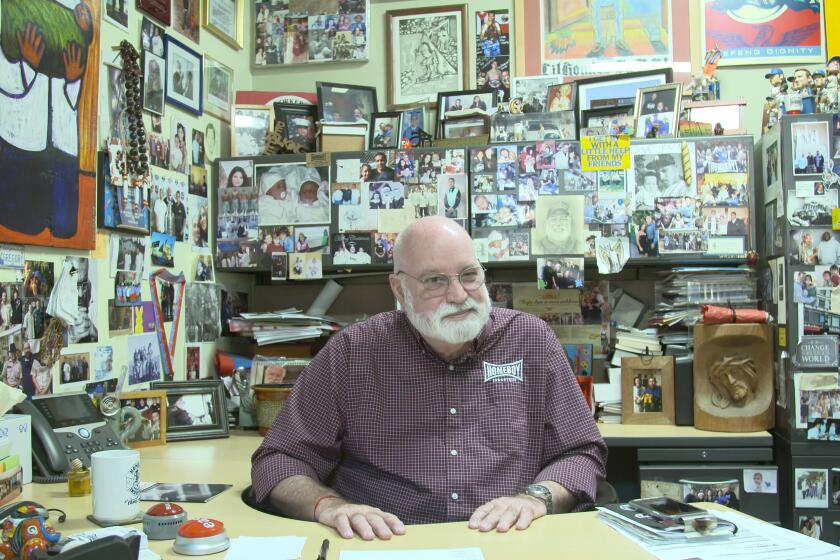Leaders in Toxic Releases : Pollution: Four firms produced 95% of air emissions around Glendale in 1990. The overall amount declined 10% in Southern California, but rose 6% in Glendale.
In the San Fernando Road industrial area, a Glendale company makes rubbery materials to seal aircraft fuel tanks and skyscraper windows. Last year, the firm, Products Research & Chemical Corp., released 162,974 pounds of toxic chemicals into the skies above Glendale and surrounding Los Angeles.
Not far away, on the Los Angeles side of San Fernando Road, Philips Components, a factory that produces ceramic capacitor chips for the circuitry of automobile heaters, radios and televisions, last year vented 150,098 pounds into the air.
A printing plant nearby in Los Angeles, Bertco Graphics on Glendale Boulevard, accounted for 75,600 pounds more. And Nelson Name Plate, a Casitas Avenue factory that stamps out manufacturers’ metal identification plates--placed on products as diverse as dishwashers and sailboat masts--added 139,479 pounds of toxic air emissions.
These four firms were responsible for 95% of the total air emissions in Glendale and the Northeast Los Angeles neighborhoods, according to annual reports the companies filed with the federal government last summer.
The businesses, along with nine other firms, released 554,871 pounds of toxic air emissions, or slightly less than 2% of the Los Angeles County total.
Some of the toxic compounds cause smog. Some deplete the Earth’s protective ozone layer. Some are believed to cause cancer and reproductive harm in humans.
However, beyond those broad conclusions, industrial, scientific and environmental experts say it is impossible to pinpoint what immediate and precise health effects occur from the release--in the course of manufacturing processes--of tons upon tons of chemicals in the region.
“The real story is told by exposure,” Robert Pease, planning manager for the air toxics division of the South Coast Air Quality Management District, said of health risks. The inventory does not measure exposure.
Complex factors contribute to air pollution risks, he said, including meteorology and the concentration and dilution of chemicals. Also, the Glendale area does not exist in isolation but is part of the larger Los Angeles Basin. Chemicals in the air migrate from place to place in Southern California.
Air experts say it is known, however, that manufacturing pollutants, along with other sources such as power plants, account for 20% of the region’s smog. Automobile and truck traffic is blamed for even more--50%.
The requirement to file the toxic emission reports is based on a federal “community right to know” law passed in 1986 by Congress in reaction to the chemical disaster at a Union Carbide plant in Bhopal, India. Two thousand people died there and 200,000 more were injured.
The annual pollution inventory is by no means perfect, said Hacienda Heights environmentalist Wil Baca, who is a board member of the Coalition for Clean Air, but he said it has helped to keep companies more environmentally honest.
“It does put them on notice that they’ve got to discipline themselves to reduce the use of toxics,” he said.
The 1990 Southern California air emission figures--drawn by The Times from the annual reports filed last summer with the U.S. Environmental Protection Agency--do, in fact, reflect a continuing downward trend. The totals dropped by 10%.
However, whereas the overall total of Los Angeles County dropped 14%, 13 Glendale and neighboring Los Angeles manufacturers bucked a nationwide and regional trend last year by reporting a slight increase--6%--in the total amount of toxic chemicals they legally vented.
Air experts attribute this partly to the growth of a few individual Glendale area businesses, such as Nelson Name Plate.
Still, Robert Pease said “generally, we’re seeing a downward trend, and we think that is a positive trend.”
Government officials, scientists, environmental activists and industry representatives attribute the decline to a combination of factors.
These include the overall economic slowdown and companies’ fears of adverse pollution publicity combined with their desires to appear as environmental “good neighbors.”
In addition, the decline is attributed to the movement away from the use of toxic chemicals, owing partly to the federal Clean Air Act and to increasingly strict regulations of the local air district, which is extracting higher and higher permit fees for the manufacturing use of certain chemicals.
From large companies to small, local executives stressed that they are doing what they can to cut down on toxic chemicals. Furthermore, they said that within the next few years, and certainly within the coming decade, they will have found alternatives for many toxic compounds and converted away from solvent-based cleaning agents, degreasers, paints, adhesives and sealants.
At Nelson Name Plate, founded locally in 1946, the change is coming gradually, company President Tom Cassutt said.
The 220-worker Los Angeles company is trying to come up with alternatives for toxic chemicals such as trichloroethane, or TCA, which is used in paints. Already, he said, this chemical has become a substitute for other hydrocarbon-based chemicals that pose more smog-related problems than does TCA.
Water-based solvents are being tried for paints that are used on all sorts of nameplates. But “they’re still not as durable and for the toughest applications can’t be used,” Cassutt said, citing sailboat masts.
In spite of these attempts at reducing the quantity of toxic chemicals released into the air, Nelson reported a 4% increase in its air emissions. The increase, Cassutt said, can essentially be attributed to a boom in business--a 15% increase in the last two years that required the hiring of 20 more employees.
Like Nelson Name Plate, officials at Products Research & Chemical Corp., an international company with 600 employees at its Glendale operations, say they are converting gradually.
“It’s difficult to find solvents that are strong enough to clean the equipment. But we anticipate finding another route,” said Mel Young, director of health, safety and environmental affairs.
The company ranked No. 1 on the list of local manufacturers reporting air emissions.
“Most of the increase is from production,” Young said. “It’s a growing business with the exception of right now, when nobody’s business is growing.”
In all probability, the release of toxic chemicals from the Glendale area will drop significantly in the next report because one of the four largest polluters has left the area: Philips Components, a 500-employee plant run by a Dutch-based firm.
The plant, which reported the second-highest local toxic air release figures, shut down in June. The Colorado Boulevard operations, just west of Glendale, are now being moved to the Texas-Mexico border cities of El Paso-Juarez, where environmental regulations are lax and labor is cheaper, said manufacturing operations manager Ross Fritz.
“This factory was moved to Mexico,” Fritz said the other day as he and a few remaining workers were cleaning up at the Colorado Boulevard facility.
Business was jeopardized by competition, he said, within a world market where firms in the Near East and Far East can make the same products as those produced in Glendale but at lower costs.
The move, he said, “has nothing really to do with getting away from environmental regulations. That would not have been the straw that broke the camel’s back.”
Still, he said, environmental regulations were one factor. And, he said, “you could talk about pay scales, or you could even talk about the aggravation of driving on freeways. But it was a business decision.”
So, Fritz said, “there’ll be cleaner air now.”
One of the criticisms of the annual air reports is that they offer only a partial, hazy snapshot of the volume of chemicals released each year into the nation’s air, land and water.
The federal toxic release inventory law covers only manufacturers, exempting industries such as agribusiness and mining, government facilities and electric utility plants.
A further gap results from the incomplete list of chemicals subject to the inventory, in which 340 chemicals are monitored but hundreds more are not. And manufacturers who use less than 10,000 pounds of a listed chemical don’t have to report it.
Even within the limited scope, the federal survey is acknowledged to be compromised by inaccuracies and reporting omissions.
The experiences of a Glendale area printing firm, Bertco Graphics on Glendale Boulevard, and the San Gabriel Valley operations of Miller Brewing Co. in Irwindale point to the extent the reporting may be flawed.
Federal reports, on file with the California Environmental Protection Agency, show that Bertco recorded a phenomenal 30,140% jump in its air emissions of trichloroethane. In 1987, 1988 and 1989, the reports indicate the firm released 250 pounds of the toxic compound. In 1990, the amount jumped to 75,600 pounds.
Bertco President Chuck Stay, who said he could not readily find copies of the reports his company filed, said he believed the 1990 figure of 75,600 pounds is accurate and the others are not.
Last year’s figure represents, he said, about a one-third increase from the previous year’s totals, which were about 56,750 pounds--not 250 pounds.
He could not explain the discrepancy.
“If that’s what the report shows, that’s what the report shows,” Stay said. “I would expect there was an increase in the use of trichloroethane. About a 33% increase . . .” But by no means, he said, a 30,000% jump.
In the case of Miller, the flawed figures related to ammonia air emissions reported for 1987, the first year required for the nationwide inventory. That year, the firm reported that in the process of using a refrigeration piping system that snakes through the cavernous Irwindale plant and cools beer in huge tanks, it released 100,000 pounds of ammonia into the air around the Foothill Freeway facility.
For the subsequent two years, the amount reported dropped to 19,000 pounds. By last year, it was 8,450 pounds.
The big drop, Miller officials sheepishly acknowledged in a recent interview, actually resulted from a case of over-reporting of the 1987 figure.
Miller spokesman Victor Franco explained by saying that the 1987 air emissions total included an extra 75,000 pounds of ammonia that had been purchased for a new refrigeration system being installed that year. However, he said, only a fraction of the 75,000 pounds was injected into the system. Even less, he said, would have escaped into the air.
“There seems to have been some error in reporting of the ammonia released,” Franco said. “I’ve got to believe if we were confused and reported inaccurately, other companies did the same.”
How to Obtain Toxic Release Data
Toxic release data for specific manufacturers--or all manufacturers within a ZIP code, a city or an entire county--can be obtained from the California Environmental Protection Agency in Sacramento.
Data-seekers can call the Cal EPA help desk at (916) 327-1848, or write: Cal EPA, Office of Environmental Information, 555 Capitol Mall, Room 525, Sacramento, Calif. 95814.
Floppy discs containing a full year of data for the entire state may also be purchased for $50 each. Discs are available for 1987, ‘88, ’89 and ’90.
Toxic Chemicals and Their Effects
Compounds emitted to the air in the largest volumes by Southern California manufacturers.
Chemical: Human and Environmental Effect
1,1,1-Trichloroethane: TCA for short. A clear liquid used to degrease metal and to clean printing presses and electronic parts, among other things. Fairly low in toxicity; a high dose is needed to cause immediate effects. Concentrated exposure can irritate the eyes and lungs and affect the heartbeat and central nervous system. Workers have died from high exposure in enclosed spaces. No link with cancer has been proved in limited animal tests. TCA depletes the ozone shield that screens the sun’s harmful rays.
Methylene Chloride: A clear liquid used as paint stripper, metal degreaser and in adhesives, foam and plastics processing. Common ingredient in paint strippers sold to consumers. Irritates skin and in high concentrations affects heart and central nervous system. Considered a probable human carcinogen based on animal tests.
Freon 113: An odorless, colorless gas used as a blowing agent in foam manufacture, as a refrigerant and as a cleaning solvent. Widely used because of its low toxicity, although high levels can cause eye, nose and throat irritation and asphyxia. Strong ozone depleter.
Perchloroethylene: Also known as PCE or tetrachloroethylene. Used in metal drying and degreasing. Also the most widely used dry-cleaning chemical. Detected in many local drinking water supplies due to ground water seepage. Moderately toxic. Workplace exposure has resulted in liver, kidney and central nervous system effects. Considered a probable human carcinogen based on animal tests.
Acetone: Flammable liquid used as fingernail polish remover; also to make chemicals, remove paint, and clean and dry precision equipment. Toxicity is low, but at high levels it can irritate the nose and throat and cause lightheadedness. Reacts in sunlight to create smog.
Ammonia: A colorless liquid or gas with irritating odor used as a household cleaner, as a refrigerant, in metal treating and synthetic fibers. Concentrated fumes can cause severe irritation to eyes and lungs.
Styrene: A flammable, usually colorless, oily liquid with pungent odor used in the manufacture of plastics and resins. One of the most heavily used chemicals in the United States. Can irritate eyes, nose and throat. Vapors contribute to smog. Suspected carcinogen.
Methyl Ethyl Ketone: MEK for short. A solvent used to make paints, paint removers, adhesives, drugs, cosmetics and artificial leather. Explosion hazard. Concentrated exposure can cause dizziness, headaches and blurred vision. Chronic, low-level exposure can cause decreased memory and slow reflexes. May cause reproductive harm, based on animal studies.
Toluene: A flammable liquid used as a gasoline additive and in making inks, detergents and pharmaceuticals. Skin and eye irritant. Chronic exposure may cause anemia, damage to liver, kidneys and central nervous system. Contributes to ozone, the main ingredient in smog. May be toxic to fetus.
Xylene: A flammable liquid used in fuels, lacquers and such household products as glues, fingernail polish and rubber cement. Can irritate eyes, nose and throat. Chronic exposure can damage the liver and central nervous system. Fatalities have resulted from breathing intense concentrations. Xylene vapors contribute to smog.
Glycol Ethers: Used in resins, paints, dyes, cosmetics and brake fluids. Concentrated exposure can cause nausea, headaches and kidney damage. May be toxic to fetus.
n-Butyl Alcohol: A flammable liquid used as a solvent in the manufacture of resins, varnishes, detergents and lacquers. Can cause skin, eye and throat irritation.
Top Polluters in the Glendale Area
Manufacturing firms are required to provide statistics on emissions of about 340 chemicals as part of a “community right to know” law passed by Congress in 1986. The numbers on the map correspond to the ranking of the companies according to the amount of toxic emissions generated.
Estimated emissions in 1990 % Main (in change Company Address product pounds) ‘89-’90 1. Products 5430 San Sealants 162,974 -3 Research & Fernando Road, Chemical Glendale Corp. 2. Philips 4561 Colorado Ceramic 150,098 +12 Components* Blvd., capacitator Los Angeles chips 3. Nelson Name 3191 Casitas Name tags, 139,479 +4 Plate Co. Ave., etching Los Angeles etching 4. Bertco 1855 Glendale Printing 75,600 +30,140 Graphics Blvd., Los Angeles
Main pollutants emitted 1. Trichloroethane 2. Methylene chloride, Freon 113 3. TCA 4. TCA
* Scheduled to close in 1991
Source: California Environmental Protection Agency
More to Read
Start your day right
Sign up for Essential California for news, features and recommendations from the L.A. Times and beyond in your inbox six days a week.
You may occasionally receive promotional content from the Los Angeles Times.






